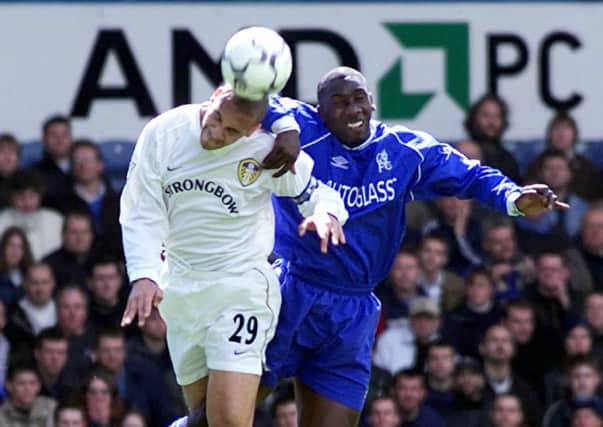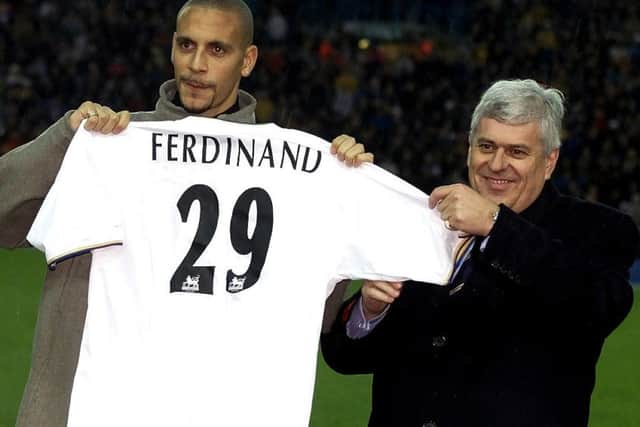Bygones: Desire to be the best marked out Ferdinand as one of Leeds’ finest


Fifteen years ago this week, Rio Ferdinand moved to Elland Road in a British record £18m transfer that suggested the club’s future was as bright as the famous white shirt the 22-year-old was about to sport.
Eddie Gray was O’Leary’s assistant at the time and readily recalls the surprise that even those within the club’s inner sanctum felt over the capture of the hottest property in English football.
Advertisement
Hide AdAdvertisement
Hide Ad“Everyone knew about Rio from a very young age,” Gray told The Yorkshire Post this week. “He was very highly thought of as a young player and, to tell you the truth, David thought another of the big clubs would nip in.


“We had a chat and said, ‘No-one else has made a move so, if we make a bid, we might just get him’. And, in the end, we did.”
Ferdinand’s arrival, the fruits of a chase that had begun six months earlier almost immediately after United had clinched a Champions League place with a goalless draw at Upton Park, came during a week that also saw Real Madrid visit Elland Road.
Heady days indeed for a club who seemed on the verge of a return to the time when Don Revie’s side had been feared across Europe.
Advertisement
Hide AdAdvertisement
Hide Ad“We were on the up as a club and pushing,” says Gray. “I think Rio looked at the young players we had at Leeds at the time and wanted to be part of that. It proved to be a great move for his career.”
Ferdinand went on to enjoy a stellar 18 months at Elland Road. His debut, however, was one to forget as the record signing struggled alongside Lucas Radebe and Jonathan Woodgate in a three-man defence that Leicester City picked apart to claim a 3-1 win at Filbert Street.
Soon, though, the new arrival was showing the form that had persuaded Leeds to pay a world record transfer fee for a defender.
“Rio had a great thirst for knowledge when he was younger,” recalls Gray, who still attends every United game on behalf of the club’s TV station, LUTV.
Advertisement
Hide AdAdvertisement
Hide Ad“Obviously, he moved on to greater things at Manchester United and with England. But, at Leeds, he was always wanting to know about the great players and how they played. And what made them good. Rio was a football fanatic.
“The thing about top players like Rio is that, as well as being gifted, they work hard, train hard and listen. That is what Rio was like.
“He listened a lot to David, who had been a top centre-back. David knew the position and Rio appreciated that.
“Mind, as much as he was willing to listen to others, Rio was also his own man. He knew what would make him a top player.
Advertisement
Hide AdAdvertisement
Hide Ad“Rio was very driven, too. We would play head tennis together, singles, and I don’t think he ever beat me. It used to drive him mad because he was so competitive.
“When my pal Jimmy Lumsden went to Manchester United (with David Moyes), I said, ‘Make sure you mention the head tennis to Rio’. I’m sure he will have laughed.”
Ferdinand quickly settled in Yorkshire and became a popular member of the dressing room.
Back then, I worked for a sports agency that put together United’s matchday programme. Part of my duties included ghosting the captain’s column, which during 2001-02 meant dealing with the Londoner.
Advertisement
Hide AdAdvertisement
Hide AdHe was good fun, loving nothing more than having a bit of mischief at a team-mate’s expense. Or mine one particular hungover morning (me, not him...), when I turned up at Thorp Arch not realising I was sporting one black shoe and one brown shoe.
“I love being different in terms of what I wear, mate,” said Ferdinand, barely able to stifle his giggles. “But that look is never, ever going to catch on!”
That one season sporting the armband proved to be Ferdinand’s swansong at Elland Road. A hugely impressive 2002 World Cup coupled with Leeds again missing out on the riches of Champions League qualification meant Manchester United’s overtures could not be repelled.
“Rio wasn’t at our club for a long time but I would say it helped his career a lot,” says Gray.
Advertisement
Hide AdAdvertisement
Hide Ad“What it did was show him a club where expectation levels were high. That is no disrespect to West Ham. But Rio had to deliver at Leeds. It was a good learning experience for him to come to Leeds.
“He left the comfort of where he had been brought up and, I felt, he grew up as a man while with us.
“I also think he developed hugely as a player. His game did change. At first, he had a tendency to dive in. Funnily enough, Jonathan Woodgate never did. I think Rio learned from that.
“Rio realised he had the pace and the vision to read the game like Woody. And he stopped going to ground.
Advertisement
Hide AdAdvertisement
Hide Ad“In the end, his style was like Bobby Moore but a lot quicker. Serene, almost.”
Ferdinand’s move to Old Trafford in the summer of 2002 for £29.1m made the Londoner, once again, the world’s costliest defender after he had been usurped a few months when Lilian Thuram joined Juventus from Parma for £22m.
“He had to leave because of our finances,” says Gray, “But our club did get a fantastic fee. Certainly, compared to what we sold Woodgate for a few months later. That was a steal.
“Personally, I would love to have seen Rio and Woody play together regularly for our club. People say Rio was a replacement for Woody but we wanted them to play together. I saw a lot of similarities between them.
Advertisement
Hide AdAdvertisement
Hide Ad“Unfortunately, Rio went to Manchester United and Woody eventually went to Real Madrid when, ideally, the two of them would have played together for a lot of years.”
Ferdinand went on to win countless honours at Old Trafford and this subsequent success did not come as a surprise to Gray.
“Rio could have played midfield,” he added. “That is the best compliment you can pay a centre-half. He has to go down as one of the best centre-backs England have ever had.
“The funny thing is that the club he came from probably had the best centre back in Bobby Moore. Personally, I have always believed Norman Hunter was a better club player.
Advertisement
Hide AdAdvertisement
Hide Ad“But Bobby was a better international player. Rio had as much talent as Bobby but maybe Bobby was more of an inspirational leader.
“He never got flustered, you couldn’t rough him up. Certainly not at international level. You only have to look at the great things that Pele said about Bobby Moore to know what sort of footballer he was.
“But Rio, for me, was right up there.”